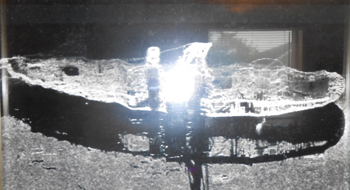The Limitation Act in Admiralty Law
by Twain Braden

A 2002 side scan sonar image of the remains of the paddle wheel steamship Portland on the bottom about 14 miles east of Plymouth, MA. High wind and seas drove the ship off course, tore off the super structure, swamping and sinking the ship.
Maritime law is full of heartbreaking contradictions. Consider this: After the steamship Portland sank in a gale in November 1898, killing all 192 people on board, the vessel’s owners filed a petition for limitation of liability in federal court in Portland. The petition, if approved, would allow the owners to protect themselves from liability. In the event of a total loss, such as the complete destruction of the steamship Portland, this value was obviously zero, since nothing was left of the ship save a few liferings and broken timbers. As a result, and as the court later found, the families of the lost passengers and crewmembers were eligible for nothing. Zero. The effects of the accident devastated hundreds of families, not just emotionally but financially, since many of the passengers and crew were the families’ breadwinners.
Fast forward 100 years. A passenger on the M/S Scotia Prince was continuously harassed by a photographer, inexplicably dressed in a gorilla suit, as the vessel transited between Maine and Nova Scotia. Throughout the voyage, she was photographed against her wishes, taunted with lewd comments, and even had to retreat to her cabin for several hours to find respite from the photographers’ relentless and obnoxious solicitations. Upon return to shore, she filed a complaint against the vessel and her owners for intentional infliction of emotional distress. She was awarded $5,000 for “emotional distress” because the court found that the defendant shipowner, as the employer of the photographer, was responsible for his actions, which constituted “extreme and outrageous conduct.” (Muratore v. M/S Scotia Prince, et al, 845 F.2d 347 (1st Cir. 1988.)
To be sure, the passenger’s treatment by the photographers was awful, and maybe the vessel operators deserved the court’s rebuke for sanctioning or not restraining his behavior. But how can the law countenance such seemingly unfair outcomes: a passenger badgered by a hooligan in a gorilla suit is awarded a fair amount of money, but the families of passengers and crew whose loved ones were killed get nothing?
The answer is that Congress chose this approach, or, rather, it has chosen to address one issue (protecting shipowners from devastating losses) but ignore another (mistreatment of passengers), leaving the courts to fill in the void. The Limitation Act stands as a potentially cruel (and blunt) instrument for use by shipowners (and also, recently, owners of yachts) to protect themselves from paying excessive damages in the event of a major loss.
Here’s how it works. Passed by Congress in 1851, the Limitation Act enabled shipowners to limit their liability to the value of the ship and her cargo after the loss. Back when the Act was passed, shipping was considered a risky venture, so if a condition occurred on board that was outside the “privity or knowledge” of the shipowner after the vessel left port, such as a poor decision by the captain or an unknown condition on the vessel herself, the shipowner could shield itself from liability. Sometimes the value of the ship and cargo was calculated by whatever flotsam and jetsam was recovered, as little as a few hundred dollars. The Act was intended to induce investment in shipping without undue fear of catastrophic losses.
Today, the Act survives but has been severely curtailed by the modern realities of shipping, in which record-keeping and technological advancements have strained the viability of a defense. It’s tough for an owner to claim lack of knowledge of a problem if it is in contact with the captain and crew wherever they are in the world, every day, at all hours of the day or night, including up until the final minutes prior to departure. A problem with a ship can be easily reported and will likely leave a paper trail.
This didn’t stop TOTE Maritime Services from filing a Limitation proceeding following the loss of El Faro in October 2015, claiming that when the vessel left port on her ill-fated journey she was equipped with “suitable engines, machinery, apparel, appliances, personnel, and other appropriate and necessary equipment, all in good order and condition and suitable for their intended operations.” And it didn’t stop the owners of the duck boat (“Ride the Ducks”) that sank on Table Rock Lake in Missouri in the summer of 2018, killing 17 people, from doing the same. Because the Act is strict about filing requirements (a shipowner must file a petition to limit its liability within six months of a claim), this sets up an immediate face-off between the shipowner and the bereaved families, who are rightfully shocked to learn that the vessel owner regards the lives of their lost loved ones as literally worthless before the law. The reality is, however, is that this statute jump-starts settlement discussions. Instead of litigating endlessly, the shipowner can avoid the risk that a judge might find the owners had knowledge of a problematic condition prior to the ship sailing, and the families can avoid the devastating effects of lengthy litigation. Harsh as it is, it’s the system we have, and, unless Congress steps into the fray to change the law, it’s the system we’ll have for some time.
Twain Braden is a partner at the Portland firm Thompson Bowie & Hatch, LLC, where he specializes in maritime and admiralty law: tbraden@thompsonbowie.com
